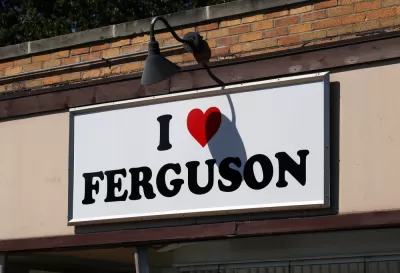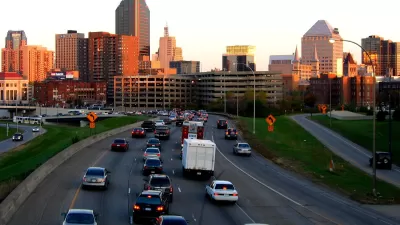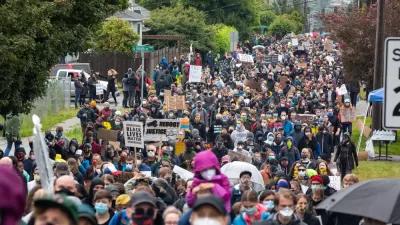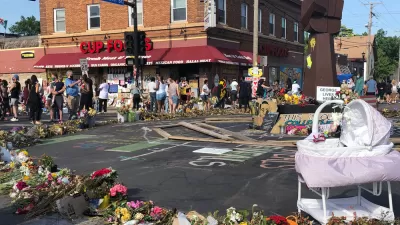Do protests and riots inevitably lead to crime waves and flight to suburbia? Not always.

As some of the protests of the last few weeks degenerated into riots and looting, some people suggested that this was just another nail in the coffin of urban life, and that just as the riots of the 1960s led to middle-class flight and urban blight, these riots will have similar effects. At first glance, this seemed to me like an implausible claim: in Detroit alone, the 1967 riots led to 43 deaths. By contrast, Wikipedia's listing of riot-related deaths suggests that no more than one or two deaths in any city were even arguably riot-related. But the discussion made me wonder: have recent race-related riots had any obvious negative impact on their cities?
Over the past decade, several cities have had riots roughly comparable to those of recent weeks: that is, they related to police killings of African-Americans. Perhaps the most widely publicized riots of the past decade have occurred in St. Louis and its suburbs. In 2014 and 2015, a variety of protests and riots arose out of the police shooting of Michael Brown in Ferguson (a low-income suburb), leading to some injuries, as well as property damage. The 2014 police shooting of Antonio Martin in Berkeley (another suburb) caused some not-entirely-peaceful protests, and the 2017 acquittal of a police officer for the death of Anthony Lamar Smith also led to some looting and vandalism and arrests. (As far as I can tell, nobody died.) Furthermore, crime has risen in St. Louis. Between 2010 and 2014, the number of homicides ranged from 113 to 159. By contrast, the number has ranged from 187 to 205 over the past five years.* I am not sure whether the riots contributed to these problems (either by changing police conduct or by making citizens more reluctant to work with police to solve crimes). Not surprisingly, people have fled St. Louis at an even faster rate than usual: according to Census estimates, the city's population decreased by only 3000 people between 2010 and 2015, and then decreased by 16,000 between 2015 and 2019.
Baltimore is also notorious for 2010s rioting; in 2015, the death of Freddie Gray at the hands of the police led to protests and riots; over 100 police officers were injured, though no one died as a result of the riots. Baltimore too experienced an upsurge in crime; between 2010 and 2014, there were between 196 and 233 homicides in Baltimore, while in 2015 there were 344, and there were over 300 in each of the following four years. Baltimore gained population in the first half of the decade, and lost almost 30,000 people between 2015 and 2019, suggesting that post-2015 crime wave might have played a role.
In 2016, Charlotte experienced some rioting after Keith Lamont Scott was shot by a police officer; although the rioting was less widespread than in other cities, it appears that one person was actually murdered in the course of the riots. But unlike Baltimore and St. Louis, Charlotte continues to grow, and it does not appear that crime rose generally. The city had 67 homicides in 2016; that number surged to 86 in 2017, but then went back down to 59 in 2018. Charlotte continues to gain population every year.
Oakland, California has experienced repeated riots—one in 2010 after transit police shot Oscar Grant, and another in 2014 as part of the national protests arising out of the deaths of Michael Brown and Eric Garner at police hands. Yet Oakland has become safer over the years; between 2010 and 2013, the number of homicides in Oakland oscillated between 90 and 127, then declined to 80 to 85 between 2014 and 2016, and then declined again to between 69 and 75 to the past three years. Oakland's population continues to grow every year, perhaps because people priced out of San Francisco continue to move to Oakland.
So what can we get out of all this? First, a riot or two does not doom a city to depopulation or to an explosion of crime; some cities have experienced riots without scaring off their population. Second, the places that have suffered the most after riots seem to have been cities that were losing people before the riots, like Baltimore and St. Louis. It may be that riots didn't matter very much.
Why did crime explode in Baltimore and St. Louis but not in Oakland? The question certainly deserves further research. One possible explanation is that riots are a bit like COVID-19: just as COVID-19 is more dangerous for an immunocompromised person than for a young, healthy one, riots are more dangerous for an already-declining city. A second explanation is that police recruiting or the lack thereof might matter: for example, Oakland added police officers over the past several years, while the other three cities lost hundreds of officers. A third explanation might be that because the Baltimore and St. Louis protests were more widely publicized, they affected police conduct or police/community relations in some hard-to-quantify way (for example, by affecting citizens' willingness to cooperate with police).**
*Municipal crime statistics can be found at City-data.com profiles of individual cities, and at various editions of the FBI's annual crime reports.
**This explanation may be supported by evidence of recent crime spikes in Minneapolis, where the death of George Floyd sparked recent protests.

Study: Maui’s Plan to Convert Vacation Rentals to Long-Term Housing Could Cause Nearly $1 Billion Economic Loss
The plan would reduce visitor accommodation by 25,% resulting in 1,900 jobs lost.

North Texas Transit Leaders Tout Benefits of TOD for Growing Region
At a summit focused on transit-oriented development, policymakers discussed how North Texas’ expanded light rail system can serve as a tool for economic growth.

Using Old Oil and Gas Wells for Green Energy Storage
Penn State researchers have found that repurposing abandoned oil and gas wells for geothermal-assisted compressed-air energy storage can boost efficiency, reduce environmental risks, and support clean energy and job transitions.

Private Donations Propel Early Restoration of Palisades Playground
Los Angeles has secured over $1.3 million in private funding to restore the Pacific Palisades playground months ahead of schedule, creating a modern, accessible space that supports community healing after recent wildfires.

From Blight to Benefit: Early Results From California’s Equitable Cleanup Program
The Equitable Community Revitalization Grant (ECRG) program is reshaping brownfield redevelopment by prioritizing projects in low-income and environmental justice communities, emphasizing equity, transparency, and community benefits.

Planting Relief: Tackling Las Vegas Heat One Tree at a Time
Nevada Plants, a Las Vegas-based nonprofit, is combating the city’s extreme urban heat by giving away trees to residents in underserved neighborhoods, promoting shade, sustainability, and community health.
Urban Design for Planners 1: Software Tools
This six-course series explores essential urban design concepts using open source software and equips planners with the tools they need to participate fully in the urban design process.
Planning for Universal Design
Learn the tools for implementing Universal Design in planning regulations.
Ascent Environmental
Borough of Carlisle
Institute for Housing and Urban Development Studies (IHS)
City of Grandview
Harvard GSD Executive Education
Toledo-Lucas County Plan Commissions
Salt Lake City
NYU Wagner Graduate School of Public Service






























